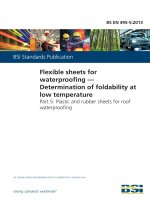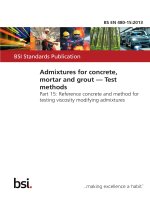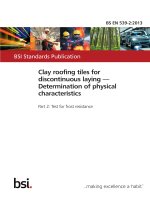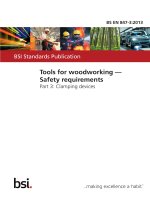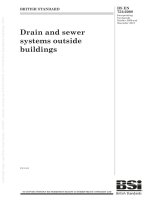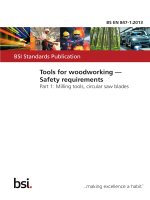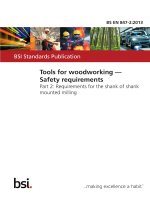Bsi bs en 61968 100 2013
Bạn đang xem bản rút gọn của tài liệu. Xem và tải ngay bản đầy đủ của tài liệu tại đây (2.21 MB, 116 trang )
BS EN 61968-100:2013
BSI Standards Publication
Application integration at
electric utilities — System
interfaces for distribution
management
Part 100: Implementation profiles
BS EN 61968-100:2013 BRITISH STANDARD
National foreword
This British Standard is the UK implementation of EN 61968-100:2013. It is
identical to IEC 61968-100:2013.
The UK participation in its preparation was entrusted to Technical
Committee PEL/57, Power systems management and associated inform-
ation exchange.
A list of organizations represented on this committee can be obtained on
request to its secretary.
This publication does not purport to include all the necessary provisions of
a contract. Users are responsible for its correct application.
© The British Standards Institution 2013.
Published by BSI Standards Limited 2013
ISBN 978 0 580 77557 4
ICS 33.200
Compliance with a British Standard cannot confer immunity from
legal obligations.
This British Standard was published under the authority of the
Standards Policy and Strategy Committee on 30 November 2013.
Amendments/corrigenda issued since publication
Date Text affected
EUROPEAN STANDARD BS EN 61968-100:2013
NORME EUROPÉENNE
EUROPÄISCHE NORM EN 61968-100
ICS 33.200 November 2013
English version
Application integration at electric utilities -
System interfaces for distribution management -
Part 100: Implementation profiles
(IEC 61968-100:2013)
Intégration d'applications pour les services Integration von Anwendungen in Anlagen
électriques - Interfaces système pour la der Elektrizitätsversorgung -
gestion de distribution - Systemschnittstellen für Netzführung -
Partie 100: Profils de mise en œuvre Teil 100: Implementations-Profile
(CEI 61968-100:2013) (IEC 61968-100:2013)
This European Standard was approved by CENELEC on 2013-08-30. CENELEC members are bound to comply
with the CEN/CENELEC Internal Regulations which stipulate the conditions for giving this European Standard
the status of a national standard without any alteration.
Up-to-date lists and bibliographical references concerning such national standards may be obtained on
application to the CEN-CENELEC Management Centre or to any CENELEC member.
This European Standard exists in three official versions (English, French, German). A version in any other
language made by translation under the responsibility of a CENELEC member into its own language and notified
to the CEN-CENELEC Management Centre has the same status as the official versions.
CENELEC members are the national electrotechnical committees of Austria, Belgium, Bulgaria, Croatia, Cyprus,
the Czech Republic, Denmark, Estonia, Finland, Former Yugoslav Republic of Macedonia, France, Germany,
Greece, Hungary, Iceland, Ireland, Italy, Latvia, Lithuania, Luxembourg, Malta, the Netherlands, Norway, Poland,
Portugal, Romania, Slovakia, Slovenia, Spain, Sweden, Switzerland, Turkey and the United Kingdom.
CENELEC European Committee for Electrotechnical Standardization
Comité Européen de Normalisation Electrotechnique
Europäisches Komitee für Elektrotechnische Normung
CEN-CENELEC Management Centre: Avenue Marnix 17, B - 1000 Brussels
© 2013 CENELEC - All rights of exploitation in any form and by any means reserved worldwide for CENELEC members.
Ref. No. EN 61968-100:2013 E
BS EN 61968-100:2013
EN 61968-100:2013 - 2 -
Foreword
The text of document 57/1358/FDIS, future edition 1 of IEC 61968-100, prepared by IEC/TC 57,
"Power systems management and associated information exchange" was submitted to the IEC-
CENELEC parallel vote and approved by CENELEC as EN 61968-100:2013.
The following dates are fixed: (dop) 2014-05-30
(dow) 2016-08-30
• latest date by which the document has
to be implemented at national level by
publication of an identical national
standard or by endorsement
• latest date by which the national
standards conflicting with the
document have to be withdrawn
Attention is drawn to the possibility that some of the elements of this document may be the subject of
patent rights. CENELEC [and/or CEN] shall not be held responsible for identifying any or all such
patent rights.
Endorsement notice
The text of the International Standard IEC 61968-100:2013 was approved by CENELEC as a
European Standard without any modification.
In the official version, for Bibliography, the following notes have to be added for the standards
indicated:
IEC 61968-9 NOTE Harmonised as EN 61968-9.
IEC 61968-13 NOTE Harmonised as EN 61968-13.
IEC 61970-452 NOTE Harmonised as EN 61970-452.
IEC 61970-453 NOTE Harmonised as EN 61970-453.
IEC 62361-100 NOTE Harmonised as EN 62361-100.
BS EN 61968-100:2013
- 3 - EN 61968-100:2013
Annex ZA
(normative)
Normative references to international publications
with their corresponding European publications
The following documents, in whole or in part, are normatively referenced in this document and are
indispensable for its application. For dated references, only the edition cited applies. For undated
references, the latest edition of the referenced document (including any amendments) applies.
NOTE When an international publication has been modified by common modifications, indicated by (mod), the relevant EN/HD
applies.
Publication Year Title EN/HD Year
IEC 60050-300 - International Electrotechnical Vocabulary - - -
Electrical and electronic measurements and
measuring instruments - Part 311: General
terms relating to measurements - Part 312:
General terms relating to electrical
measurements - Part 313: Types of electrical
measuring instruments - Part 314: Specific
terms according to the type of instrument
IEC 61968-1 - Application integration at electric utilities - EN 61968-1 -
System interfaces for distribution
management - Part 1: Interface architecture
and general requirements
IEC/TS 61968-2 - Application integration at electric utilities - - -
System interfaces for distribution
management - Part 2: Glossary
IEC 61968-11 - Application integration at electric utilities - EN 61968-11 -
System interfaces for distribution
management - Part 11: Common information
model (CIM) extensions for distribution
IEC 61970-301 - Energy management system application EN 61970-3011) -
program interface (EMS-API) - Part 301:
Common information model (CIM) base
IEC 61970-552 - Energy Management System Application EN 61970-5521) -
Program Interface (EMS-API) - Part 552:
CIMXML Model Exchange Format
ISO 8601 - Data elements and interchange formats - - -
Information interchange - Representation of
dates and times
1) At draft stage.
– 2 – BS EN 61968-100:2013
61968-100 © IEC:2013
CONTENTS
INTRODUCTION ..................................................................................................................... 8
1 Scope...............................................................................................................................9
2 Normative References .................................................................................................... 10
3 Terms, definitions and abbreviations ..............................................................................10
3.1 Terms and definitions ............................................................................................ 10
3.2 Abbreviations ........................................................................................................ 10
3.3 Terminology for common integration technologies .................................................11
3.3.1 General ..................................................................................................... 11
3.3.2 Enterprise Service Bus (ESB) .................................................................... 12
3.3.3 Java Messaging Service (JMS) .................................................................. 12
3.3.4 Service-Oriented Architecture (SOA) ......................................................... 12
3.3.5 Event-Driven Architecture (EDA) ............................................................... 12
3.3.6 Simple Object Access Protocol (SOAP) ..................................................... 12
3.3.7 Web Services (WS) ................................................................................... 13
3.3.8 Web Services Definition Language (WSDL) ............................................... 13
3.3.9 XML Schema (XSD)................................................................................... 13
3.3.10 Representational State Transfer (REST).................................................... 14
3.3.11 Queue ....................................................................................................... 14
3.3.12 Topic ......................................................................................................... 14
3.3.13 Message Destination ................................................................................. 14
3.3.14 Request ..................................................................................................... 14
3.3.15 Response .................................................................................................. 14
3.3.16 Query ........................................................................................................ 15
3.3.17 Transaction ............................................................................................... 15
3.3.18 Event ......................................................................................................... 15
4 Use Cases...................................................................................................................... 15
4.1 General ................................................................................................................. 15
4.2 Simple request/reply..............................................................................................16
4.3 Request/reply using an ESB .................................................................................. 16
4.4 Events ................................................................................................................... 17
4.5 Transactions ......................................................................................................... 18
4.6 Callback ................................................................................................................ 19
4.7 Adapters................................................................................................................ 20
4.8 Complex messaging .............................................................................................. 21
4.9 Orchestration ........................................................................................................ 22
4.10 Application-level use cases ................................................................................... 22
5 Integration Patterns ........................................................................................................ 23
5.1 General ................................................................................................................. 23
5.2 Client and server perspectives .............................................................................. 23
5.2.1 General ..................................................................................................... 23
5.2.2 Basic web service pattern .......................................................................... 24
5.2.3 Basic JMS request/reply pattern ................................................................ 24
5.2.4 Event listeners........................................................................................... 26
5.2.5 Asynchronous request/reply pattern........................................................... 27
5.3 Bus perspective.....................................................................................................27
BS EN 61968-100:2013 – 3 –
61968-100 © IEC:2013
5.3.1 General ..................................................................................................... 27
5.3.2 ESB messaging pattern using JMS ............................................................ 28
5.3.3 ESB messaging patterns using web service request .................................. 29
5.3.4 ESB request handling to web service ......................................................... 29
5.3.5 ESB request handling via adapter .............................................................. 30
5.3.6 Custom integration patterns ....................................................................... 31
6 Message organization..................................................................................................... 32
6.1 General ................................................................................................................. 32
6.2 IEC 61968 messages ............................................................................................ 32
6.2.1 General ..................................................................................................... 32
6.2.2 Verbs......................................................................................................... 33
6.2.3 Nouns........................................................................................................ 34
6.2.4 Payloads ................................................................................................... 35
6.3 Common message envelope..................................................................................36
6.3.1 General ..................................................................................................... 36
6.3.2 Message header structure ......................................................................... 37
6.3.3 Request message structures ..................................................................... 40
6.3.4 Response Message Structures .................................................................. 43
6.3.5 Event message structures ......................................................................... 48
6.3.6 Fault message structures .......................................................................... 49
6.4 Payload structures................................................................................................. 50
6.5 Strongly-typed payloads ........................................................................................ 53
6.6 SOAP message envelope ......................................................................................54
6.7 Request processing...............................................................................................55
6.8 Event processing...................................................................................................56
6.9 Message correlation .............................................................................................. 57
6.10 Complex transaction processing using OperationSet .............................................57
6.10.1 General ..................................................................................................... 57
6.10.2 OperationSet Element ............................................................................... 59
6.10.3 Patterns..................................................................................................... 61
6.10.4 OperationSet example ............................................................................... 63
6.11 Representation of time .......................................................................................... 65
6.12 Other conventions and best practices ....................................................................65
6.13 Technical interoperability.......................................................................................65
6.14 Service level agreements ...................................................................................... 66
6.15 Auditing, monitoring and management...................................................................66
7 Payload specifications .................................................................................................... 66
8 Interface specifications ................................................................................................... 70
8.1 General ................................................................................................................. 70
8.2 Application-level specifications ..............................................................................70
8.3 Web service interfaces .......................................................................................... 72
8.3.1 General ..................................................................................................... 72
8.3.2 WSDL Structure......................................................................................... 72
8.3.3 Document style SOAP binding ................................................................... 73
8.3.4 Strongly-typed web services ...................................................................... 74
8.4 JMS....................................................................................................................... 76
8.4.1 General ..................................................................................................... 76
8.4.2 Topic and queue naming ........................................................................... 77
8.4.3 JMS message fields................................................................................... 78
– 4 – BS EN 61968-100:2013
61968-100 © IEC:2013
9 Security .......................................................................................................................... 78
10 Version control ............................................................................................................... 79
Annex A (normative) XML schema for common message envelope ......................................81
Annex B (normative) Verbs .................................................................................................. 91
Annex C (normative) Procedure for strongly typed WSDL generation ...................................93
Annex D (normative) Generic WSDL .................................................................................. 106
Annex E (informative) AMQP ............................................................................................. 108
Annex F (informative) Payload Compression Example ....................................................... 109
Annex G (informative) XMPP ............................................................................................. 111
Bibliography........................................................................................................................ 112
Figure 1 – Overview of Scope .................................................................................................9
Figure 2 – Simple Request/Reply..........................................................................................16
Figure 3 – Request/reply using intermediaries ......................................................................17
Figure 4 – Events.................................................................................................................. 18
Figure 5 – Point-to-Point (One Way) Pattern ......................................................................... 19
Figure 6 – Transaction Example............................................................................................ 19
Figure 7 – Callbacks ............................................................................................................. 20
Figure 8 – Use of Adapters ................................................................................................... 21
Figure 9 – Complex messaging ............................................................................................. 22
Figure 10 – Application-level use case example....................................................................23
Figure 11 – Basic request/reply using web services ..............................................................24
Figure 12 – Basic request/reply using JMS ........................................................................... 25
Figure 13 – Event listeners using JMS .................................................................................. 26
Figure 14 – Asynchronous request/reply pattern ................................................................... 27
Figure 15 – ESB content-based routing.................................................................................28
Figure 16 – ESB with smart proxy and content-based routing................................................29
Figure 17 – ESB with proxies, routers and adapters .............................................................. 30
Figure 18 – ESB Integration to non-compliant resources .......................................................31
Figure 19 – Messaging between clients, servers and an ESB................................................33
Figure 20 – Example payload schema...................................................................................35
Figure 21 – Common message envelope ..............................................................................37
Figure 22 – Common message header structure ...................................................................39
Figure 23 – Request message structure ................................................................................41
Figure 24 – XML for example RequestMessage ....................................................................42
Figure 25 – Example 'Get<Noun>' profile ..............................................................................43
Figure 26 – ResponseMessage structure .............................................................................. 44
Figure 27 – Reply message states ........................................................................................ 45
Figure 28 – Error structure.................................................................................................... 46
Figure 29 – XML for example ResponseMessage..................................................................47
Figure 30 – XML example of payload compression ............................................................... 47
Figure 31 – XML example for error ResponseMessage .........................................................48
Figure 32 – EventMessage structure ..................................................................................... 48
BS EN 61968-100:2013 – 5 –
61968-100 © IEC:2013
Figure 33 – XML example for EventMessage ........................................................................49
Figure 34 – Fault message structure .....................................................................................50
Figure 35 – Message payload container – Generic................................................................51
Figure 36 – Message payload container – Type specific example .........................................54
Figure 37 – SOAP bindings .................................................................................................. 54
Figure 38 – SOAP envelope example for strong typing .........................................................55
Figure 39 – Message OperationSet Element .........................................................................58
Figure 40 – OperationSet details...........................................................................................60
Figure 41 – Transactional Request/Response (non-OperationSet) ........................................61
Figure 42 – Published events (non-OperationSet) ................................................................. 62
Figure 43 – Transactional Request/Response (OperationSet) ...............................................62
Figure 44 – Published event (OperationSet)..........................................................................63
Figure 45 – Information Models, Profiles and Messages .......................................................67
Figure 46 – Contextual Profile Design in CIMTool .................................................................67
Figure 47 – Example message payload schema.................................................................... 68
Figure 48 – Example payload XML schema...........................................................................69
Figure 49 – Example message XML ......................................................................................70
Figure 50 – Example complex business process ...................................................................72
Figure 51 – WSDL structure ..................................................................................................73
Figure 52 – Web service usage example...............................................................................76
Figure 53 – Example Organization of Topics and Queues .....................................................77
Figure C.1 – Process for WSDL Generation .......................................................................... 93
Figure C.2 –Example sequence diagram ...............................................................................94
Figure C.3 – WSDL folder structure ......................................................................................94
Figure C.4 – WSDL type definitions ...................................................................................... 95
Figure D.1 – Generic WSDL structure ................................................................................. 106
Table 1 – Verbs and their Usage...........................................................................................34
Table 2 – Payload usages..................................................................................................... 53
Table B.1 – Normative definitions of verbs ............................................................................91
– 8 – BS EN 61968-100:2013
61968-100 © IEC:2013
INTRODUCTION
This part of IEC 61968 defines a set of implementation profiles for IEC 61968 using
technologies commonly used for enterprise integration. More specifically, this document
describes how message payloads defined by parts 3-9 of IEC 61968 are conveyed using web
services and the Java Messaging System. Guidance is also provided with respect to the use
of Enterprise service Bus (ESB) technologies. The goal is to provide details that would be
sufficient to enable implementations of IEC 61968 to be interoperable. In addition, this
document is intended to describe integration patterns and methodologies that can be
leveraged using current and future integration technologies.
The IEC 61968 series of standards is intended to facilitate inter-application integration as
opposed to intra-application integration. Intra-application integration is aimed at programs in
the same application system, usually communicating with each other using middleware that is
embedded in their underlying runtime environment, and tends to be optimised for close, real-
time, synchronous connections and interactive request/reply or conversation communication
models. IEC 61968, by contrast, is intended to support the inter-application integration of a
utility enterprise that needs to connect disparate applications that are already built or new
(legacy or purchased applications), each supported by dissimilar runtime environments.
Therefore, these interface standards are relevant to loosely coupled applications with more
heterogeneity in languages, operating systems, protocols and management tools. This series
of standards, which are intended to be implemented with middleware services that exchange
messages among applications, will complement, not replace utility data warehouses,
database gateways, and operational stores.
This standard is based upon the EPRI Technical Report 1018795 and other contributed works.
The IEC 61968 series, taken as a whole, defines interfaces for the major elements of an
interface architecture for distribution systems within a utility enterprise. Part 1: Interface
Architecture and General Recommendations, identifies and establishes requirements for
standard interfaces based on an Interface Reference Model (IRM). Parts 3 through 9 of
IEC 61968 define interfaces relevant to each of the major business functions described by the
Interface Reference Model.
As described in IEC 61968, there are a variety of distributed application components used by
the utility to manage electrical distribution networks. These capabilities include monitoring and
control of equipment for power delivery, management processes to ensure system reliability,
voltage management, demand-side management, outage management, work management,
automated mapping, meter reading, meter control and facilities management. This set of
standards is limited to the definition of interfaces and is implementation independent. It
provides for interoperability among different computer systems, platforms, and programming
languages. Methods and technologies used to implement functionality conforming to these
interfaces are considered outside of the scope of these standards; only the interface itself is
specified in these standards.
BS EN 61968-100:2013 – 9 –
61968-100 © IEC:2013
APPLICATION INTEGRATION AT ELECTRIC UTILITIES –
SYSTEM INTERFACES FOR DISTRIBUTION MANAGEMENT –
Part 100: Implementation profiles
1 Scope
This part of IEC 61968 specifies an implementation profile for the application of the other
parts of IEC 61968 using common integration technologies, including JMS and web services.
This International Standard also provides guidance with respect to the use of Enterprise
Service Bus (ESB) technologies. This provides a means to derive interoperable
implementations of IEC 61968-3 to IEC 61968-9. At the same time, this International Standard
can be leveraged beyond information exchanges defined by IEC 61968, such as for the
integration of market systems or general enterprise integration.
Figure 1 attempts to provide an overview of scope, where IEC 61968 compliant messages are
conveyed using web services or JMS. Through the use of an ESB integration layer, the
initiator of an information exchange could use web services, where the receiver could use
JMS, and vice versa. The integration layer also provides support for one to many information
exchanges using publish/subscribe integration patterns and key functionality such as delivery
guarantees.
WS - Direct Interaction w/o Integration Layer
Web Service Web Service
Client Service
Client or Server WS WS
using another
??? ESB ??? Client or Server
integration using another
technology Integration
integration
Application Layer technology
using JMS
JMS JMS Application
using JMS
JMS – Direct integration using a JMS server
IEC 1769/13
Figure 1 – Overview of Scope
The scope of this document specifically includes the following:
• integration patterns that support IEC 61968 information exchanges
• design of interfaces for use of strongly typed web services
• design of interfaces for use of generically typed web services
• design of interfaces using JMS
– 10 – BS EN 61968-100:2013
61968-100 â IEC:2013
ã definition of standard design artefacts and related templates
• recognition that technologies other than JMS and web services may be used for
integration leveraging this standard (with some specific examples and associated
recommendations described in appendices)
This profile can also be applied to integration problems outside the scope of IEC 61968.
It is important to note that other implementation profiles can potentially be defined for
IEC 61968, and that this is not intended to be the only possible implementation profile. In
addition, this profile can be adapted to meet specific needs of specific integration projects.
It is also not within the scope of this document to prescribe those implementation details as
required for security.
2 Normative References
The following documents, in whole or in part, are normatively referenced in this document and
are indispensable for its application. For dated references, only the edition cited applies. For
undated references, the latest edition of the referenced document (including any
amendments) applies.
IEC 60050-300, International Electrotechnical Vocabulary – Electrical and electronic
measurements and measuring instruments – Part 311: General terms relating to
measurements – Part 312: General terms relating to electrical measurements – Part 313:
Types of electrical measuring instruments – Part 314: Specific terms according to the type of
instrument
IEC 61968-1, Application integration at electric utilities – System interfaces for distribution
management – Part 1: Interface architecture and general recommendations
IEC/TS 61968-2, Application integration at electric utilities – System interfaces for distribution
management – Part 2: Glossary
IEC 61968-11, Application integration at electric utilities – System interfaces for distribution
management – Part 11: Common information model (CIM) extensions for distribution
IEC 61970-301, Energy management system application program interface (EMS-API) –
Part 301: Common information model (CIM) base
IEC 61970-552, Energy management system application program interface (EMS-API) –
Part 552: CIM XML Model Exchange Format
ISO 8601, Data elements and interchange formats – Information interchange –
Representation of dates and times
3 Terms, definitions and abbreviations
3.1 Terms and definitions
For the purposes of this specification, the terms and definitions given in IEC 60050-300,
IEC/TS 61968-2, IEC 62051, IEC 62055-31 apply.
3.2 Abbreviations
The following terms and abbreviations are used within this document:
BS EN 61968-100:2013 – 11 –
61968-100 © IEC:2013
API Application Programming Interface
AMQP Advanced Message Queue Protocol
CIM Common Information Model
CME Common Message Envelope
CRUD Create, Read, Update, Delete
EDA Event Driven Architecture
ESB Enterprise Service Bus
IEC International Electrotechnical Commission
IETF RFC Internet Engineering Task Force Request For Comments
ISO International Standards organization
JEE Java Enterprise Edition
JMS Java Message Service
JSR Java Specification Request
mRID CIM master resource identifier
OASIS Organization for the Advancement of Structured Information Standards
RDF Resource Description Framework
REST REpresentational State Transfer
RFC Request for Comments
SOA Service Oriented Architecture
SOAP Simple Object Access Protocol
SSL Secured Socket Layer
TLS Transport Layer Security
UML Unified Modelling Language
URL Uniform Resource Locators
UUID Universal Unique Identifier
W3C World-Wide Web Consortium
WS Web Services
WS-* Web Services standards
WS-I Web Services Interoperability
WSDL Web Services Definition Language
XML eXtensible Markup Language
XSD XML Schema
XSL XML Stylesheet Language
3.3 Terminology for common integration technologies
3.3.1 General
Where there is a difference between the definitions in this standard and those contained in
other referenced IEC standards, then those defined in IEC/TS 61968-2 shall take precedence
over the others listed, and those defined in this document shall take precedence over those
defined in IEC/TS 61968-2.
– 12 – BS EN 61968-100:2013
61968-100 © IEC:2013
3.3.2 Enterprise Service Bus (ESB)
An Enterprise Service Bus (ESB) refers to a software architecture construct that is used as an
integration layer. This construct is typically implemented by technologies found in a category
of middleware infrastructure products, usually based on recognized standards, which provide
foundational services for more complex architectures via an event-driven and standards-
based messaging engine (the bus).
An ESB generally provides an abstraction layer on top of an implementation of an enterprise
messaging system, which allows integration architects to exploit the value of messaging
without writing code. Contrary to the more classical enterprise application integration (EAI)
approach of a monolithic stack in a hub and spoke architecture, the foundation of an
enterprise service bus is built of base functions broken up into their constituent parts, with
distributed deployment where needed, working in harmony as necessary.
An ESB does not implement a service-oriented architecture (SOA) but provides the features
with which one may be implemented.
3.3.3 Java Messaging Service (JMS)
The Java Message Service (JMS) API is a Java Message Oriented Middleware API for
sending messages between two or more clients. JMS supports request/reply,
publish/subscribe and point to point messaging patterns. JMS is a part of the Java Platform,
Enterprise Edition, and is defined by a specification developed under the Java Community
Process as JSR 914.It is important to note that some ESB product vendors provide language
bindings for JMS using C, C++ and/or C#, making the term JMS a misnomer. Where the wire
protocol is different between different JMS implementations it is often trivial to bridge between
different JMS implementations.
3.3.4 Service-Oriented Architecture (SOA)
Service Oriented Architecture (SOA) is a computer systems architectural style for creating
and using business processes, packaged as services, throughout their lifecycle. SOA also
defines and provisions the IT infrastructure to allow different applications to exchange data
and participate in business processes. These functions are loosely coupled with the operating
systems and programming languages underlying the applications. SOA separates functions
into distinct units (services), which can be distributed over a network and can be combined
and reused to create business applications. These services communicate with each other by
passing data from one service to another, or by coordinating an activity between two or more
services. SOA concepts are often seen as built upon and evolving from older concepts of
distributed computing and modular programming.
3.3.5 Event-Driven Architecture (EDA)
Event-Driven Architecture (EDA) is a software architecture pattern that promotes the
production, detection and consumption of events. An event is any change of state of potential
interest. Within an EDA, events are transmitted between loosely coupled software
components and services, typically using publish/subscribe messaging patterns. EDA is
complementary to SOA, to the extent that SOA 2.0 is also known as ‘event-driven’ SOA. EDA
is fundamental to a variety of business intelligence patterns, including complex event
processing patterns.
3.3.6 Simple Object Access Protocol (SOAP)
The Simple Object Access Protocol (SOAP) is a standard that defines the formatting of XML
messages. SOAP serves as a foundation layer of the web services protocol stack. SOAP is
also commonly used within JMS. Common transports for SOAP include HTTP, HTTPS and
proprietary JMS transports. SOAP is also now sometimes referred to as ‘Service-Oriented
Architecture Protocol’. SOAP is a W3C Recommendation.
BS EN 61968-100:2013 – 13 –
61968-100 © IEC:2013
Two versions that are in common use include SOAP 1.1 and SOAP 1.2. New integrations or
interfaces should use SOAP 1.2 when applicable.
3.3.7 Web Services (WS)
A Web Service is defined by the W3C as ‘a software system designed to support
interoperable Machine to Machine interaction over a network.’ Web services are frequently
just Web APIs that can be accessed over a network, such as the Internet, and executed on a
remote system hosting the requested services.
The W3C Web service definition encompasses many different systems, but in common usage
the term refers to clients and servers that communicate using XML messages that follow the
SOAP standard. Common in both the field and the terminology is the assumption that there is
also a machine readable description of the operations supported by the server written in the
Web Services Description Language (WSDL). The latter is not a requirement of a SOAP
endpoint, but it is a prerequisite for automated client-side code generation in many Java
and .Net development tools.
Where web services have two primary styles, document-centric and RPC-centric, the focus of
this specification is document-centric. This is supportive of SOA and the transport of
IEC 61968 payloads. For increased interoperability, the document wrapped form is required.
It is important to note that web services do not readily support publish/subscribe messaging
unless mechanisms such as WS-Eventing are used. However, this specification also
describes an approach for the ESB to route messages asynchronously to configured
subscribers.
This standard will discuss two approaches for use of web services, where WSDL operations
are either generic or strongly typed. Generic web services have WSDLs and related
operations that are defined in a payload type independent manner. Strongly typed web
services are defined where WSDLs and operations are defined individually for specific
payload types.
This also provides for automated frameworks for server-side validation of message content
based on message schemas contained in the WSDL document.
3.3.8 Web Services Definition Language (WSDL)
Web Services Definition Language (WSDL) is an XML-based language that is used to
describe web services. WSDL is often used in combination with SOAP and XML schema to
provide web services over the internet (or an intranet). WSDL is a W3C Recommendation.
Two versions that are in common use include WSDL 1.1 and WSDL 2.0.WSDL 2.0 better
supports interoperability between Java and .Net implementations.
The WSDL templates provided by this document are based upon WSDL 1.1, and
consequentially WSDL 1.1 is a requirement. In order to better support interoperability between
dverse implementations, all WSDL documents are WS-I Basic Profile 1.1 compliant.
3.3.9 XML Schema (XSD)
XML Schema, published as a W3C recommendation in May 2001, is one of several XML
schema languages. It was the first separate schema language for XML to achieve
Recommendation status by the W3C.
Like all XML schema languages, XML Schema can be used to express a schema: a set of
rules to which an XML document shall conform in order to be considered 'valid' according to
that schema. However, unlike most other schema languages, XML Schema was also designed
with the intent that determination of a document's validity would produce a collection of
– 14 – BS EN 61968-100:2013
61968-100 © IEC:2013
information adhering to specific data types. An XML Schema instance is an XML Schema
Definition (XSD) and typically has the filename extension ".xsd". The language itself is
sometimes informally referenced as XSD.
It is important to note that 61968 payload are defined using XML schemas. Those XML
schemas provide normative specifications for application payloads that are conveyed using
this standard.
3.3.10 Representational State Transfer (REST)
Representational State Transfer (REST) is an alternative to the use of SOAP-based web
services. REST itself is not currently a standard, but instead an architectural style.
REST leverages HTTP, where each URL is a representation of some object. Interfaces can be
defined in terms of XML payloads for requests and responses. A WSDL is not required for the
use of REST. Additionally, the XML documents used for requests and responses do not need
to be defined using an XSD, although it is common for the XML to be compliant to an XSD.
Within REST, an object can be retrieved (read) using an HTTP GET. Similarly, an HTTP
POST is used to create an object, an HTTP PUT is used to modify an object and an HTTP
DELETE is used to delete an object.
REST is discussed here for completeness purposes only as it may be encountered by an
integration project. However, there are currently no specific recommendations for mappings
by this standard. REST may be supported in the future.
3.3.11 Queue
A queue is a construct supported by many messaging products to provide reliable messaging
with delivery guarantees. A standard API that includes queue-based messaging models is
provided by JMS. AMQP also defines an open protocol for queue based messaging.
3.3.12 Topic
A topic is a construct supported by many messaging products to enable publish/subscribe
messaging patterns where there may be potentially many consumers of a message that has
been sent to a named topic by a publisher. Topics are commonly used as a destination for
event messages. Topics are directly supported by JMS.
3.3.13 Message Destination
A message destination is the target address for a message, whether it be a request, response
or an event message. When using JMS, the destination may be a topic or queue. When using
HTTP mechanisms such as web services, the destination is specified as a URL.
3.3.14 Request
A request is a message sent from a client (or source) to a server (or target) where a response
is expected. The request may be either a query (where data is returned from the target) or a
transaction (where data is modified in the target). A request will use verbs such as ‘get’,
‘create’, ‘change’, ‘delete’, ‘cancel’, ‘close’ or ‘execute’.
3.3.15 Response
A response is a message sent as a consequence of a request, typically from the target of the
request to the source of the request. Response messages are synonomous with ‘reply’
messages. A response message will use a ‘reply’ verb.
BS EN 61968-100:2013 – 15 –
61968-100 © IEC:2013
3.3.16 Query
A query is a type of request where the target is expected to return information to the source of
the request. The request message for a query will use the ‘get’ verb. This will typically be
implemented using a request/reply pattern.
3.3.17 Transaction
A transaction is a type of request where the target typically will modify information that it
manages. A transaction request will use verbs such as ‘create’, ‘change’, ‘delete’, ‘cancel’,
‘close’ or ‘execute’. This may be implemented using a variety of patterns. If a pattern other
than request/reply is used, there should be a delivery guarantee provided by the transport.
3.3.18 Event
The term ‘Event’ is significantly overloaded, and can have different meanings in different
contexts. The most general definition of an event is ‘something that happens at a given place
and time’, or ‘a change of state of potential interest’. As a consequence of an event,
‘something’ may generate an ‘event message’ to report the fact that a certain type of event
occurred at a given time. Event messages are therefore asynchronous in nature and are
typically published to potentially interested subscribers using topic-based messaging.
Event messages are one type of asynchronous message. It may be common for an
application to generate an event when a condition of interest is detected, or a transaction has
been processed. There are several integration patterns that are related to the support of
events.
Events are typically published asynchronously as event messages by a system or application
in order to report conditions of interest. In some cases a system or application may internally
identify a condition of interest, but in other cases the condition may be detected by an
external source such as a device. Event messages will use past tense verb such as ‘created’,
‘changed’, ‘deleted’, ‘closed’, ‘canceled’ or ‘executed’.
4 Use Cases
4.1 General
The purpose of Clause 4 is to describe several use cases related to the interactions between
components within a set of systems cooperating to support a set of business processes. It is
important to note that the use cases presented are from the perspective of the integration of
systems, as opposed to end use application-level use cases. The actors for the use cases
described in this clause include the following:
• Client
• Server
• ESB
• Adapter
• Subscriber (an Event Listener)
Three key terms related to messaging are request, reply and event. Within the terminology of
IEC 61968, these are reflected in terms of the verbs used to define specific information flows.
Central to the use cases is the assumption that a variety of integration technologies may be
used, where the focus of this standard is JMS and web services.
– 16 – BS EN 61968-100:2013
61968-100 © IEC:2013
4.2 Simple request/reply
The first use case is a simple request/reply between a client and server. This is synonymous
with request/response. The initiator of the request is the client, where the requested is
processed by the server. The first view of this is the simple view without the use of an ESB.
This use case involves one of two cases:
a) A client making a query request to a server, where the server will return a set of objects to
the client based upon some filter criteria
b) A client making a transaction request to a server, where a set of objects will be created or
modified in some way
Both cases are illustrated in Figure 2.
IEC 1770/13
Figure 2 – Simple Request/Reply
In terms of IEC 61968, requests use verbs such as "get", "create", "change", "delete", "close",
"cancel" or "execute".
4.3 Request/reply using an ESB
The simple request/reply use case can also be extended to leverage an ESB. Within the ESB
many actions can be taken by intermediaries as needed to facilitate integration and the
decoupling of components, such as transformations and routing.
BS EN 61968-100:2013 – 17 –
61968-100 © IEC:2013
IEC 1771/13
Figure 3 – Request/reply using intermediaries
A key aspect of this use case is the decoupling of the client from the server, so that the client
does not have to know the exact location of the server or conform to the exact interface used
by the server. The routing and mapping can take place in the integration layer.
It is also recommended that ESB intermediaries be stateless. The use of stateless
intermediaries simplifies the implementation of load balancing and high availability.
4.4 Events
There is often the need for client processes to be informed of an event of potential interest.
Many client processes can listen (subscribe) for events. One example of this is
EndDeviceEvents messages that may be published by a metering system. Other examples
include events that report the execution of a control or transaction, such as the creation or
update of a work order.
– 18 – BS EN 61968-100:2013
61968-100 © IEC:2013
IEC 1772/13
Figure 4 – Events
In terms of IEC 61968, events use the ‘past tense’ verbs "created", "changed", "deleted",
"canceled", "closed" or "executed".
This is an example of a one way pattern, where the sender does not expect a response at the
application level, although the transport used may allow for lower level acknowledgements in
order to facilitate delivery guarantees when needed.
Listeners that use web services will need to have an exposed interface at a URL that is known
by an intermediary so that the events can be appropriately distributed. Rules must also be
defined for retry processing where guaranteed delivery is required. The implications of
message ordering also need to be considered. Message ordering is a significant topic in itself
that may require attention in a future edition.
4.5 Transactions
The use case for a transaction is typically a combination of a request/reply exchange between
a client and a server, with a consequential publication of events. An important aspect is that
the clients and services may use different transport mechanisms, where a client may use web
services but a server may use JMS. An intermediary within the ESB can provide the
necessary routing functions.
Transactions are commonly implemented using a request/reply pattern, but they can also be
implemented using a point-to-point or one way pattern. The one way pattern can use either
present tense verbs for transactions or past-tense verbs for events and the needs of a
specific implementation may require.

